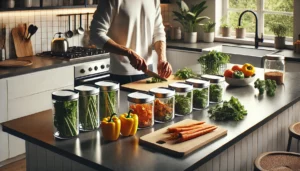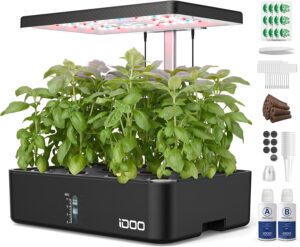Eating a plant-based diet is not only a healthy and sustainable choice, but it can also be surprisingly affordable. While it’s easy to assume that a plant-based lifestyle comes with a hefty price tag, with a bit of planning, creativity, and savvy shopping, you can enjoy nutritious, delicious meals without overspending. Here are some practical tips to help you maintain a plant-based diet while staying within your budget.

1. Buy in Bulk and Stock Up on Staples
Buying in bulk is one of the most effective ways to save money on plant-based foods. Staples like dried beans, lentils, whole grains, oats, and nuts are often significantly cheaper when purchased in bulk. Not only do these ingredients have a long shelf life, but they’re also incredibly versatile, forming the base of countless meals.
Actionable Tip: Visit bulk bins at your local grocery store or co-op to stock up on essentials. If you don’t have access to a bulk store, consider buying larger packages online or at warehouse clubs. Store bulk items in airtight containers to keep them fresh for longer.
2. Shop Seasonally for Fresh Produce
Seasonal produce is often more affordable, fresher, and tastier than out-of-season options that are shipped from far away. By focusing your meals around what’s in season, you can enjoy a variety of fruits and vegetables while keeping costs low.
Actionable Tip: Create a seasonal produce calendar or download a seasonal produce guide to keep track of what’s in season in your area. Visit farmers’ markets, where you can often find locally grown, seasonal produce at lower prices, and consider signing up for a Community Supported Agriculture (CSA) box for a regular supply of fresh, seasonal fruits and vegetables.
3. Plan Your Meals and Stick to Your List
Meal planning is key to staying within your budget. When you take the time to plan your meals for the week, you can make a precise shopping list that helps you avoid impulse buys and reduce food waste. Plus, you’ll be less likely to reach for expensive convenience foods.
Actionable Tip: Dedicate time each week to plan your meals based on what you already have in your pantry and what’s on sale at your local grocery store. Consider batch cooking meals that can be eaten throughout the week or frozen for later. Stick to your shopping list to avoid unnecessary purchases.
4. Grow Your Own Food
If you have the space and time, growing your own fruits, vegetables, and herbs can be a fun and rewarding way to save money on groceries. Even a small garden or a few pots on a windowsill can yield a surprising amount of fresh produce.
But if you’re like me and have limited space (or just want an easier way to grow your greens), a hydroponic system might be just what you need.
My Experience: I’ve been using the iDOO Hydroponics Growing System Kit at home, and it’s been a game-changer. I was skeptical at first, thinking it might be too complicated or that I wouldn’t get much out of it. But it’s honestly one of the easiest ways I’ve found to grow fresh, leafy greens indoors. The system takes care of most of the work for you—there’s a built-in LED light that’s on a timer, so you don’t even have to worry about whether your plants are getting enough sunlight. In fact, I’ve started keeping a few other plants nearby to give them some extra light, too.
What I love most is how satisfying it is to harvest greens that I’ve grown myself, even in the middle of winter. There’s something special about adding fresh herbs or lettuce from my own little indoor garden to a meal. Plus, it’s surprisingly fun to watch the plants grow day by day. Whether you have a green thumb or not, I can’t recommend it enough—it’s been a simple and enjoyable way to add a bit more homegrown goodness to my diet.
5. Cook at Home and Get Creative with Leftovers
Eating out can quickly drain your budget, but cooking at home allows you to control your costs, ingredients, and portion sizes. Home cooking also gives you the flexibility to use leftovers creatively, reducing waste and stretching your food budget even further.
Actionable Tip: Make cooking a fun and rewarding experience by experimenting with new recipes and involving the whole family. If you have leftovers, turn them into new meals—yesterday’s roasted veggies can become today’s stir-fry, and leftover grains can be transformed into hearty soups or salads.
6. Embrace Frozen Fruits and Vegetables
Frozen fruits and vegetables are often less expensive than their fresh counterparts, and they can be just as nutritious since they’re typically frozen at peak ripeness. They’re a convenient and budget-friendly option, especially when your favorite fruits and veggies are out of season.
Actionable Tip: Stock up on frozen fruits and vegetables during sales, and use them in a variety of dishes such as smoothies, stir-fries, soups, and stews. Consider freezing your own produce when it’s in season and on sale—this way, you’ll have a supply of your favorite fruits and veggies all year round.
7. Look for Deals and Use Coupons
Taking advantage of deals, discounts, and coupons can significantly reduce your grocery bill. Whether it’s clipping coupons, shopping during sales, or using loyalty programs, there are plenty of ways to save on plant-based foods.
Actionable Tip: Sign up for newsletters from your favorite brands and grocery stores to receive exclusive deals and promotions. Use apps and websites that aggregate coupons and discounts for groceries. Don’t be afraid to buy generic or store-brand items, which are often just as good as name-brand products but at a lower price.
Eating a plant-based diet on a budget is not only possible but can also be an enjoyable and fulfilling experience. By buying in bulk, shopping seasonally, planning your meals, cooking at home, using frozen foods, looking for deals, and even growing your own produce, you can nourish your body and mind without breaking the bank. Remember, the key to success is planning ahead and being resourceful—your wallet (and your health) will thank you!

